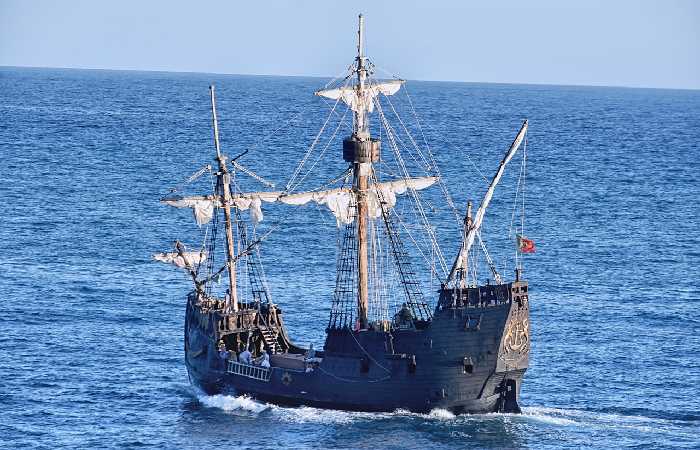Table of Contents
When did Columbus Sail the Ocean Blue
When did Columbus Sail the Ocean Blue: The Columbus sailed the Ocean Blue, but when exactly?
Christopher Columbus departed from Palos in southern Spain on August 3, 1492, with 90 sailors on the Nia, Pinta, and Santa Maria ships.
A Brief Overview of Columbus
- Since he was born in Genoa, Italy, Italian American communities frequently arranged parades to honor him.
- Columbus set out on his first maritime expedition when he was 13 years old and loved it. As a mature, he wanted to find a different way to get to China.
- After being persuaded by Columbus, Spain agreed to pay for this journey. He was the captain of several ships, including the Nina, Pinta, and Santa Maria.
- He traveled for about two months before the New World, including stops in Cuba and the Dominican Republic.
- Since he thought he was in the Indies, Columbus called the native population “Indians.” He set out for Spain in March 1493 after the king and queen named him Admiral of the Ocean Sea.
Information About The Sail
Was the journey difficult?
- It went surprisingly nicely. After reaching the Canary Islands in September, the armada once more dropped anchor. 6 and arrived in the Caribbean in under 33 days.
Not long ago, wasn’t their talk of a mutiny?
- Yes, as the trade winds blew the ships west, the sailors worried they wouldn’t be able to return home.
Columbus’ response to the mutineers
- He pacified the rebels by making threats and promises at the same time. A few days after the whining began, the land was spotted.
Where was he?
- To get close to Asia, he had landed on an island that might have been Gran Turk Island, San Salvador Island, Samana Cay in the Bahamas, or another island.
What about the natives Columbus called “Indians?
- They engaged in agriculture and lived in harmony.
How was he treating them?
- He planned to kidnap six of them to serve as his guide and convert the remainder into enslaved people for God and Spain.
Did he reach a compromise?
- No, he re-started his journey and continued his search for China and Japan, finally coming to rest on Cuban territory.
What did they discover?
- Locals were seen lighting up specific herbs, and they took a whiff of the smoke before recognizing it was tobacco.
When did he create a settlement?
- He arrived on an island he dubbed Espagnola (Hispaniola), which is now made up of Haiti, then the Dominican Republic, after navigating the Windward Passage.
- He completed this and then sailed back to his residence.
When did he arrive?
- He arrived in Palos with two of his three ships on March 14, 1493. The Santa Maria was stranded on a reef off the coast of Haiti.
A second journey came next. When did it first begin?
- This expedition left on September 1. 1,500 people, domestic animals, tools, and supplies for a permanent colony were transported on 17 ships on May 5, 1493. They got there in November.
- 16. A few days later, to everyone’s amazement, the armada made its way to Hispaniola.
What took place?
- Due to the Spanish’s terrible maltreatment of the Native Americans, Fort Navidad was destroyed, and Native Americans slaughtered its entire garrison.
- After re-establishing the colony, Columbus traveled and settled in Jamaica, only to return and find Hispaniola experiencing fresh upheaval.
How did he handle it?
- A brutal system of native exploitation was put in place, prisoners were picked up and taken to Spain to be sold as enslaved people, and the Indians were subdued.
- On March 10, 1496, he embarked on Spain.
Which Brings Us To The Third Voyage?
- It began on May 30, 1498. The flotilla reached Trinidad on July 31.
- He and his crew arrived on the Venezuelan shore on August 5, when he recognized they had found “a very vast continent, unknown till now.”
So the third voyage was a success?
No, when Columbus arrived back in Hispaniola, he found anarchy. A new governor who had taken over in his place shackled him to a vessel heading towards Spain.
Ferdinand and Isabella restored it when he got there, but his standing never entirely recovered.
Even So, A Fourth Voyage Took Place
- Yes, notwithstanding the unsatisfactory results. The ordeal of being shipwrecked in Jamaica with his soldiers utterly ruined him.
- He departed for Spain on November 1, devastated both physically and mentally. 7, 1504.
- He committed his final years to achieve the political and economic advantages he thought he and his soldiers deserved.
- On May 20, 1506, he went away in prosperity without the honors he sought.
Columbus Day
- Columbus “found” America on October 12, 1492, which was celebrated as Columbus Day 400 years later in 1892.
- In 1968, Congress agreed that Columbus Day would become a recognizing federal holiday beginning in 1971 and be commemorating on the second Monday of October.

